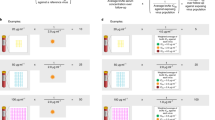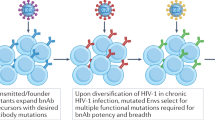Abstract
Broadly neutralizing antibodies against highly variable viral pathogens are much sought after to treat or protect against global circulating viruses. Here we probed the neutralizing antibody repertoires of four human immunodeficiency virus (HIV)-infected donors with remarkably broad and potent neutralizing responses and rescued 17 new monoclonal antibodies that neutralize broadly across clades. Many of the new monoclonal antibodies are almost tenfold more potent than the recently described PG9, PG16 and VRC01 broadly neutralizing monoclonal antibodies and 100-fold more potent than the original prototype HIV broadly neutralizing monoclonal antibodies1,2,3. The monoclonal antibodies largely recapitulate the neutralization breadth found in the corresponding donor serum and many recognize novel epitopes on envelope (Env) glycoprotein gp120, illuminating new targets for vaccine design. Analysis of neutralization by the full complement of anti-HIV broadly neutralizing monoclonal antibodies now available reveals that certain combinations of antibodies should offer markedly more favourable coverage of the enormous diversity of global circulating viruses than others and these combinations might be sought in active or passive immunization regimes. Overall, the isolation of multiple HIV broadly neutralizing monoclonal antibodies from several donors that, in aggregate, provide broad coverage at low concentrations is a highly positive indicator for the eventual design of an effective antibody-based HIV vaccine.
This is a preview of subscription content, access via your institution
Access options
Subscribe to this journal
Receive 51 print issues and online access
$199.00 per year
only $3.90 per issue
Buy this article
- Purchase on Springer Link
- Instant access to full article PDF
Prices may be subject to local taxes which are calculated during checkout




Similar content being viewed by others
Accession codes
Primary accessions
GenBank/EMBL/DDBJ
Data deposits
Gene sequences of the reported antibodies and the primers used for antibody isolation have been deposited under GenBank accession numbers JN201894–JN201927.
Change history
22 September 2011
Minor text changes were made to paragraph beginning, 'The potency and breadth of the monoclonal antibodies...', Acknowledgements and Author Contributions.
References
Wu, X. et al. Rational design of envelope identifies broadly neutralizing human monoclonal antibodies to HIV-1. Science 329, 856–861 (2010)
Walker, L. M. et al. Broad and potent neutralizing antibodies from an African donor reveal a new HIV-1 vaccine target. Science 326, 285–289 (2009)
Binley, J. M. et al. Comprehensive cross-clade neutralization analysis of a panel of anti-human immunodeficiency virus type 1 monoclonal antibodies. J. Virol. 78, 13232–13252 (2004)
Amanna, I. J., Messaoudi, I. & Slifka, M. K. Protective immunity following vaccination: how is it defined? Hum. Vaccin. 4, 316–319 (2008)
Plotkin, S. A. Immunologic correlates of protection induced by vaccination. Pediatr. Infect. Dis. J. 20, 63–75 (2001)
Barouch, D. H. Challenges in the development of an HIV-1 vaccine. Nature 455, 613–619 (2008)
Karlsson Hedestam, G. B. et al. The challenges of eliciting neutralizing antibodies to HIV-1 and to influenza virus. Nature Rev. Microbiol. 6, 143–155 (2008)
Stamatatos, L., Morris, L., Burton, D. R. & Mascola, J. R. Neutralizing antibodies generated during natural HIV-1 infection: good news for an HIV-1 vaccine? Nature Med. 15, 866–870 (2009)
Trkola, A. et al. Cross-clade neutralization of primary isolates of human immunodeficiency virus type 1 by human monoclonal antibodies and tetrameric CD4-IgG. J. Virol. 69, 6609–6617 (1995)
Stiegler, G. et al. A potent cross-clade neutralizing human monoclonal antibody against a novel epitope on gp41 of human immunodeficiency virus type 1. AIDS Res. Hum. Retroviruses 17, 1757–1765 (2001)
Burton, D. R. et al. Efficient neutralization of primary isolates of HIV-1 by a recombinant human monoclonal antibody. Science 266, 1024–1027 (1994)
Kwong, P. D. & Wilson, I. A. HIV-1 and influenza antibodies: seeing antigens in new ways. Nature Immunol. 10, 573–578 (2009)
Schief, W. R., Ban, Y. E. & Stamatatos, L. Challenges for structure-based HIV vaccine design. Curr. Opin. HIV AIDS 4, 431–440 (2009)
Simek, M. D. et al. Human immunodeficiency virus type 1 elite neutralizers: individuals with broad and potent neutralizing activity identified by using a high-throughput neutralization assay together with an analytical selection algorithm. J. Virol. 83, 7337–7348 (2009)
Haynes, B. F. et al. Cardiolipin polyspecific autoreactivity in two broadly neutralizing HIV-1 antibodies. Science 308, 1906–1908 (2005)
Mouquet, H. et al. Polyreactivity increases the apparent affinity of anti-HIV antibodies by heteroligation. Nature 467, 591–595 (2010)
Walker, L. M. et al. A limited number of antibody specificities mediate broad and potent serum neutralization in selected HIV-1 infected individuals. PLoS Pathog. 6, e1001028 (2010)
Plotkin, S. A. Orenstein, W. A. & Offit, P. A. Vaccines (Elsevier Health Sciences, Philadelphia, 2008)
Bridges, C. B. et al. Effectiveness and cost-benefit of influenza vaccination of healthy working adults: a randomized controlled trial. J. Am. Med. Assoc. 284, 1655–1663 (2000)
Herrera, G. A. et al. Influenza vaccine effectiveness among 50–64-year-old persons during a season of poor antigenic match between vaccine and circulating influenza virus strains: Colorado, United States, 2003–2004. Vaccine 25, 154–160 (2007)
Parren, P. W. et al. Antibody protects macaques against vaginal challenge with a pathogenic R5 simian/human immunodeficiency virus at serum levels giving complete neutralization in vitro. J. Virol. 75, 8340–8347 (2001)
Nishimura, Y. et al. Determination of a statistically valid neutralization titre in plasma that confers protection against simian-human immunodeficiency virus challenge following passive transfer of high-titered neutralizing antibodies. J. Virol. 76, 2123–2130 (2002)
Hessell, A. J. et al. Effective, low-titer antibody protection against low-dose repeated mucosal SHIV challenge in macaques. Nature Med. 15, 951–954 (2009)
Hessell, A. J. et al. Broadly neutralizing human anti-HIV antibody 2G12 is effective in protection against mucosal SHIV challenge even at low serum neutralizing titers. PLoS Pathog. 5, e1000433 (2009)
Willey, R., Nason, M. C., Nishimura, Y., Follmann, D. A. & Martin, M. A. Neutralizing antibody titers conferring protection to macaques from a simian/human immunodeficiency virus challenge using the TZM-bl assay. AIDS Res. Hum. Retroviruses 26, 89–98 (2010)
Martell, B. A. et al. Cocaine vaccine for the treatment of cocaine dependence in methadone-maintained patients: a randomized, double-blind, placebo-controlled efficacy trial. Arch. Gen. Psychiatry 66, 1116–1123 (2009)
Pantophlet, R. et al. Fine mapping of the interaction of neutralizing and nonneutralizing monoclonal antibodies with the CD4 binding site of human immunodeficiency virus type 1 gp120. J. Virol. 77, 642–658 (2003)
Li, M. et al. Human immunodeficiency virus type 1 env clones from acute and early subtype B infections for standardized assessments of vaccine-elicited neutralizing antibodies. J. Virol. 79, 10108–10125 (2005)
Blixt, O. et al. Printed covalent glycan array for ligand profiling of diverse glycan binding proteins. Proc. Natl Acad. Sci. USA 101, 17033–17038 (2004)
Wang, S. K. et al. Targeting the carbohydrates on HIV-1: interaction of oligomannose dendrons with human monoclonal antibody 2G12 and DC-SIGN. Proc. Natl Acad. Sci. USA 105, 3690–3695 (2008)
Richman, D. D., Wrin, T., Little, S. J. & Petropoulos, C. J. Rapid evolution of the neutralizing antibody response to HIV type 1 infection. Proc. Natl Acad. Sci. USA 100, 4144–4149 (2003)
Brochet, X., Lefranc, M. P. & Giudicelli, V. IMGT/V-QUEST: the highly customized and integrated system for IG and TR standardized V-J and V-D-J sequence analysis. Nucleic Acids Res. 36, W503–W508 (2008)
Munshaw, S. & Kepler, T. B. SoDA2: a Hidden Markov Model approach for identification of immunoglobulin rearrangements. Bioinformatics 26, 867–872 (2010)
Acknowledgements
We thank N. Schultz, K. Le and V. Thaney for technical assistance at The Scripps Research Institute. We also thank C. Corbaci, S. M. Eagol and C. Williams for assistance with Fig. 3. We would also like to thank the research staff members of the Theraclone I-STAR Discovery and Antibody Purification Team, and K. Limoli, S. Jauregui, K. Tran, P. Sitou, J. Perea, B. Huang and P. Guinto at Monogram BioSciences. We thank R. McBride for assistance with the glycan array and are grateful to W. Olson for providing purified KNH1144 SOSIP trimer, R. Wyatt for providing the YU2 Foldon trimer and J. Mascola for providing monoclonal antibody VRC01. In addition, we would like to thank all of the International AIDS Vaccine Initiative (IAVI) Protocol G project, clinical and site team members, the IAVI Human Immunology Laboratory (HIL) and all of the Protocol G clinical investigators, specifically, G. Miiro, A. Pozniak, D. McPhee, O. Manigart, E. Karita, A. Inwoley, W. Jaoko, J. DeHovitz, L.-G. Bekker, P. Pitisuttithum, R. Paris, J. Serwanga and S. Allen. This work was supported by IAVI, NIAID, the Ragon Institute and the United States for International Development (USAID). The contents are the responsibility of the authors and do not necessarily reflect the views of USAID or the United States Government.
Author information
Authors and Affiliations
Contributions
Project planning was performed by L.M.W., M.H., K.J.D., E.F., P.-Y.C.-H., R.P., J-P.J., T.W., S.P., M.D.S., W.K., I.A.W., M.M., S.F., D.R.B. and P.P.; experimental work by L.M.W., M.H., K.J.D., E.F., R.P., J.-P. J., P.-Y.C.-H., S.-K.W., A.R., J.L.M., P.W.H., O.A.O. and T.W.; data analysis by M.H., L.M.W., K.J.D., E.F., T.W., P.-Y.C.-H., D.R.B. and P.P.; composition of the first draft of the manuscript by L.M.W. and D.R.B.; manuscript layout and major manuscript revisions by M.H., K.J.D. and P.P.; revisions by R.P., J.-P.J., E.F., W.C.K. and I.A.W.
Corresponding authors
Ethics declarations
Competing interests
Po-Ying Chan-Hui, Jennifer Mitcham, Ole Olsen, Matthew Moyle, Sanjay Phogat, Pascal Poignard, Melissa Simek, Wayne Koff, Laura M. Walker and Dennis R. Burton are inventors on a patent describing the PGT antibodies. 1.PGT 127, 128, 131, 139, 145 Antibodies US 61/476,978: US provisional application filed in 4/10/11 2. PGT 127, 128, 131, 139, 145 Antibodies US 61/476,978: US provisional application filed in 4/10/11.
Supplementary information
Supplementary Information
This file contains Supplementary Tables 1-6, Supplementary Figures 1-8 with legends and Supplementary Notes. (PDF 2999 kb)
Rights and permissions
About this article
Cite this article
Walker, L., Huber, M., Doores, K. et al. Broad neutralization coverage of HIV by multiple highly potent antibodies. Nature 477, 466–470 (2011). https://doi.org/10.1038/nature10373
Received:
Revised:
Accepted:
Published:
Issue Date:
DOI: https://doi.org/10.1038/nature10373
This article is cited by
-
Absolute quantitation of binding antibodies from clinical samples
npj Vaccines (2024)
-
A classification algorithm based on dynamic ensemble selection to predict mutational patterns of the envelope protein in HIV-infected patients
Algorithms for Molecular Biology (2023)
-
Conformational antigenic heterogeneity as a cause of the persistent fraction in HIV-1 neutralization
Retrovirology (2023)
-
Probabilities of developing HIV-1 bNAb sequence features in uninfected and chronically infected individuals
Nature Communications (2023)
-
Profound structural conservation of chemically cross-linked HIV-1 envelope glycoprotein experimental vaccine antigens
npj Vaccines (2023)
Comments
By submitting a comment you agree to abide by our Terms and Community Guidelines. If you find something abusive or that does not comply with our terms or guidelines please flag it as inappropriate.



